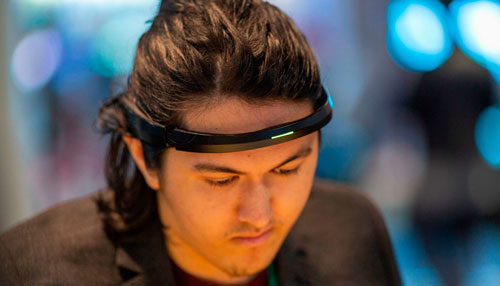Beijing
From tiredness-detecting driving glasses to shin guards that judge the performance of footballers — we’ve come a long way since the early days of the pulse-measuring smart watch.
Some of the very latest innovations in the burgeoning wearable tech sector were on display this week at the 2020 Consumer Electronics Show — offering improved ways to get online and keep on top of health issues. Smart glasses at CES sought to offer solutions to a variety of problems.
French startup Ellcie Healthy displayed its optical frames offering drowsiness alerts for drivers, and can also help detect falls in elderly people.
“This product can help save lives and reduce accidents,” said business manager Theo Niktabe of the glasses which have been sold in France and are being launched worldwide.
The drowsiness alerts may be useful for truck drivers and the discreet design — they look like normal eyewear — may get more elderly people to use them.
“We try to make smart glasses that don’t look like smart glasses,” Niktabe said. “Old people don’t want to wear devices for fall detection.”
A different kind of smart eyewear from US startup Narbis uses neurofeedback for brain exercises which can help boost concentration, notably for children with attention deficit disorders.
Using a NASA-developed algorithm, the glasses become tinted when the wearer is distracted and clear when calm and concentrating.
“You can wear this for 20 to 30 minutes a day and your brain develops the ability to pay attention better,” said Narbis’s Jay Arcata, who added that the device is also being tested for helping with certain kinds of dementia. Bosch meanwhile unveiled its eyewear giving users notifications similar to those received on a smart watch, and smart eyewear maker Vuzix showed off its connected swimming goggles which can offer information underwater.
The connected goggles can be used by professionals for training, “but you can also watch Netflix,” Vuzix CEO Paul Travers said. “Some people get bored doing laps in a pool.”
Hearables come of age
In-ear devices are one of the fastest-growing wearables categories, and there was no shortage of “hearables” at CES, for simple music and conversation as well as for health applications.
“Truly wireless earbuds are all over the place,” said analyst Jitesh Ubrani of IDC. “The costs have come down so much people are giving them away at the show.”
But more advanced services are coming to the earpieces too. Waverly Labs unveiled its over-the-ear device that can translate conversations in 20 languages.
Avi Greengart of the consultancy Techsponential said there was growth in earbuds that are “socially acceptable” for people with hearing loss. “We are seeing a rise in hearables aimed at people with hearing loss, who may need a hearing aid but aren’t willing to get one,” he said. The next step is health and medical applications.—AFP










